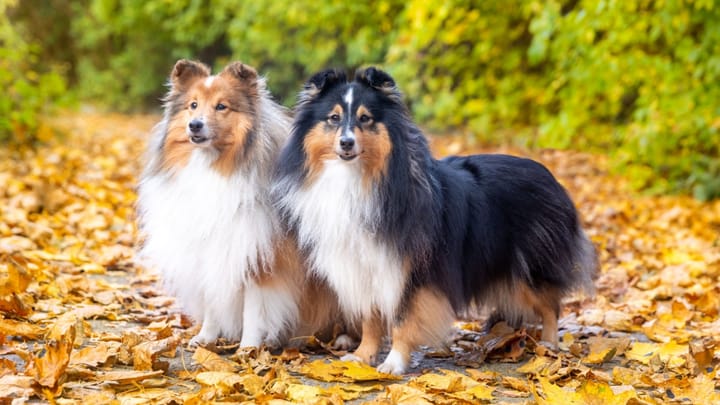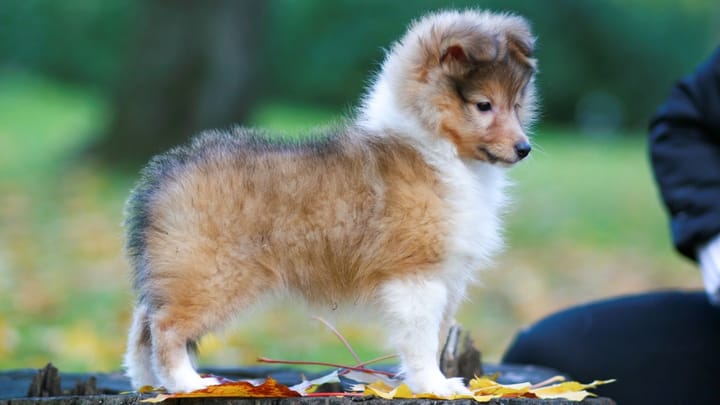Shetland Sheepdog
Other name: Sheltie


A long-haired and graceful working dog is the Sheltie. Its fur is soft and abundant, and flows elegantly across the entire body. Thicker fur around the neck of the dog gives the impression of a mane. A shapely head and a gently symmetrical body make the breed arguably one of the most pleasing to the human eye.
|
Life expectancy |
The Shetland Sheepdog has a life expectancy of between 10 and 14 years |
|
Temperament |
|
|
Size |
Small
|
|
Adult size |
Female
Between 13 and 15 in
Male
Between 14 and 15 in
|
|
Adult weight |
Female
Between 15 and 22 lb
Male
Between 15 and 22 lb
|
|
Coat colour
A Shetlie’s coat can be coloured sable, black, blue or merle. Some of the breed will have a brindle coat and others may have up to half of their coat coloured white. |
Black White Red Blue |
|
Type of coat
His hair is long. Thick, double coat consisting of an outer layer of long, weatherproof fur and an undercoat of soft, smooth hair. Smooth hair mostly adorns the dog’s head, ears and feet and an abundance of long, thick hair is found on the mane and the frill of the animal. |
Long |
|
Eye colour
The Sheltie’s eyes are usually coloured dark brown, but dogs with a merle coat may have eyes that are wholly blue or flecked with blue. |
Brown
Blue
|
|
Purchase price |
The Shetland Sheepdog costs between £775 and £910 |
Shetland Sheepdogs learn very quickly. You may only have to reinforce a command a handful of times before the dog understands what is being asked of it. Research on the intelligence of the dog concludes that they are one of the top ten brightest dogs. Because they are intelligent they are also sensitive and become very introverted if they are not treated with respect and love.
More details about the Shetland Sheepdog
Shetland Sheepdog: Origins and history
The Icelandic sheepdog is thought to be the ancestor of the Sheltie. This dog was crossed with working collies brought over from the Scottish mainland. By the early 1800s the dog that was to become the Sheltie had migrated south from the subarctic archipelago. It was further bred with rough collies and spaniels. The resulting ‘Sheltie’ quickly became a popular choice of herding dog for farmers all over the UK, and their prowess in the field has stuck ever since.
Physical characteristics of the Shetland Sheepdog
The width of the skull is in proportion to the length of the muzzle. The Sheltie’s profile is elegant and slender. Its tail is set low and long, and follows the line of the back leg. It has a longish body, and the body is slightly longer than it is tall.
FCI classification of the Shetland Sheepdog
-
Group 1 - Sheepdogs and Cattledogs (except Swiss Cattledogs)
-
Section 1 : Sheepdogs
Shetland Sheepdog: Characteristics
Shetland Sheepdog: Behaviour
Training a Shetland Sheepdog
Exceptionally easy to train is the Sheltie. Training however must be done right: a confident master who is consistent and varies their style of training is essential. Shetland Sheepdogs get bored easily of routine.
Shetland Sheepdog: Lifestyle
Breed compatibility Shetland Sheepdog
Shetland Sheepdog: Purchase price
The price for a Shetland Sheepdog can vary according to its origin, gender and age. For a dog registered at the Kennel Club, they will cost approximately £910.
Concerning your average monthly budget to satisfy your Shetland sheepdog’s needs, it will vary between £120 to £160.
Shetland Sheepdog: Shedding
Heavy !
The long, dense and furry coat of the Sheltie sheds a lot. These dogs are not suitable for people who are allergic to dog hair and dander. The amount of moult produced by this dog must be taken into account before bringing a Sheltie into your home.
Shetland Sheepdog: Grooming
The Shetland Sheepdog's coat should be brushed at least once a week to remove loose lint and dander, and to prevent the fur from becoming tangled. Brush all the way through the fur to the skin to ensure the best results. Always wet the Sheltie’s fur before brushing otherwise your grooming will damage the dog’s outer coat.
Shetland Sheepdog: Health
12 to 14 years.
A Shetland Sheepdog outdoors will not care what the weather is like. Originating in the harsh climate of the Shetland Islands (north of Scotland) this breed is robust and not generally prone to illnesses, chills or sickness.
The Shetland Sheepdog does not tolerate hot weather overly well. A ‘thin and trim’ haircut will help the dog to get through the hottest time of the year.
The double coat of the Shetland Sheepdog keeps the dog warm even when walking in the snow.
Weight gain can be a feature of the Sheltie. If your Sheltie is not exercised as regularly as it should be and is fed too much human or substandard food it will become obese.
- Collie eye anomaly
- Distichiasis
- Hip dysplasia
- Hypothyroidism
- Legg-Perthes disease (Legg-Calvé-Perthes)
- Luxating patellas
- Progressive retinal atrophy
- Von Willebrand's disease





